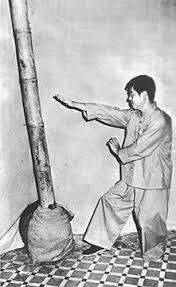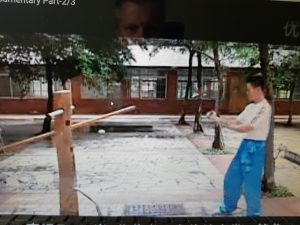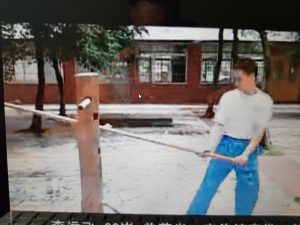Shaolin Mok-Ka (sometimes referred to as Shaolin Mok-Ga).
Siu Lum Mok Ga in Cantonese and Shaolin Mò Jiā in Mandarin
The Shaolin Mok-Ka style of Kung Fu
Originally developed, so legend has it, by a midget called Mok Da Si in the Shaolin monastery in Southern China. He taught it to his family in the Tong Kwun district of Kwong Tong province in Southern China. Until the third generation, the style was known only as Shaolin Chuen, then it was named Mok-Ka (Mok’s family) when a very outstanding boxer called Mok Ching Gill was responsible for making the system more well known by defeating more than 500 boxers of various styles in the Tong Kwun district and surrounding area.
The style has passed virtually unchanged through the generations and is still taught faithfully according to its original concept; sharing the same good reputation with the four other contemporary southern family styles, Hung, Choi, Lee and Lau. There is a traditional saying which, when translated, calls to mind the strong points of three of these styles – “Hung’s fists, Mok’s kicks and Lee’s staff”.
The Mok-Ka style by tradition has two wooden dummies for practice. One called Mook-Yan Chon has projections like arms and is used for blocking and countering. The second, called a Darn-Gee, is peculiar only to the Mok-Ka style, and consists of a hollow bamboo post 13 feet high by 4 inches diameter set into the ground by about 3 feet and filled with washers (originally coins).

Darn-Gee
 |
 |
Mook-Yan Chon
This is used to practice all of the attacks a student learns, such training is a terrific aid to building power into punches and kicks. Every student passes through a stage where he must demonstrate the power of his attacks using a Darn-Gee, he must develop a considerable amount of power before progressing with his training.
The 108 movements which are the basis of the Mok-Ka style can be used in many ways from just a single punch (which may be all that is needed to win a fight) to multiple jumping kicks. The student must be capable of expressing every movement he knows, every attack, every counter, every defence from any position and at any time, in order to be sure that he is not restricted.
Sifu Charles Chan studied Mok-Ka in Hong Kong, where the three leading seniors of the style were Sifu Cheung Wing Fai*, (who was Sifu Chan’s teacher). Sifu Mok Hoi who was over 80 years of age, and Sifu Mok Chon, who was over 70. After coming to England, Sifu Chan opened a Kung Fu club in Coventry. As well as teaching the Mok Ka style of unarmed combat he also taught various forms of weaponry, such as Kwun (Long Staff), Leung Gip Kwun (Split Staff), Siu So Gee (Little Sweeper), Sam Gip Kwun (Three Section Staff), Guay (Tonfa), Te Chec (Sai), Lau Yip Do (Broadsword) and Dip Do (Butterfly Swords). Advanced students progress through their training learning basic movements with many of the weapons; until they are ready to specialise in the type of weapon to which they are particularly suited. As in all of the training, it is the capabilities of the students that will decide the type of training course he will follow.
Later, when the advanced student is experienced in the Mok Ka style, he progresses on to learning a “soft” form of Kung Fu, called Taiji, a form having many variations, the one learnt by students of Sifu Chan being “Wu” style. Based on the Taoist symbol of Yin and Yang. Taiji teaches one to be aware of, and to react to, any form of attack – to be ever changing and formless.
To learn and combine these two systems of Kung Fu is not an easy task, but, once acquired, the knowledge and experience prove to be very valuable indeed.
This is not to say that a student who studies for many years will automatically become a devastating fighter; it depends upon the individual. It is up to each student to learn what he can, to develop what he is good at, and to express himself to his utmost. A teacher helps the student to develop himself and to discover his own path, it is the student’s responsibility to himself to take that path. This the traditional principle on which Sifu Charles Chan and Sifu Rob Morgan base their teaching.
~ Sifu Rob Morgan ~
* Sifu Cheung Wing Fai was one of the first students to become a Master outside of the Mok Family. Sifu Cheung Wing Fai was also a herbalist and bonesetter. He used to treat fractures, internal injuries, dislocations etc.